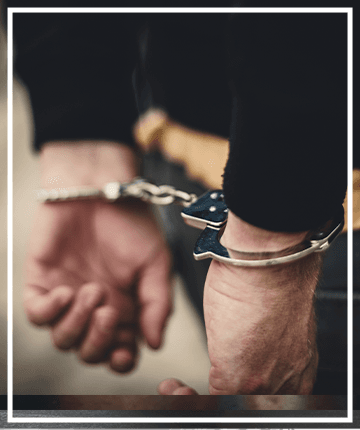
Orange County One-Leg-Stand Test
Our Southern California Attorneys Can Advise You on Your Rights Regarding this Field Sobriety Test
This test must be performed on a hard, dry, level, non-slippery surface. Conditions must be such that the suspect would be in no danger if they were to fall. Certain wind/weather conditions may interfere with and affect the validity of this test. This test should not be given to persons who are more than 65 years of age, are more than 50 pounds overweight, or have physical impairments that interfere with balance. Individuals wearing heels more than two inches high should be given the opportunity to remove their shoes, as this may diminish the reliability of the results. The officer is trained not to give this test if there is not adequate lighting to perform it. In total darkness, even the average sober person may have difficulty with this test, due to their visual frame of reference being taken away.
It is imperative that the officer observe the DWI suspect from at least three feet away and remain as motionless as possible while the suspect is performing this test. If this is not done, the test may be interfered with, and this could ultimately affect the results and validity. In the administration of this DUI test, there are two separate stages involved. The first stage is called the “Instruction” Stage. The test is initiated by giving verbal instructions, accompanied by demonstrations of those instructions. The officer is trained to advise the suspect to stand with their heels together and arms down at their sides. The officer must demonstrate this. The officer must also inform the suspect not to start the test until told to do so and must receive an indication from the suspect that they understand the instructions so far and document this acknowledgement. There are no scoring factors involved until the suspect is into the next stage (the Balance and Counting Stage), unless the suspect cannot perform the test at all. This would give the suspect a maximum score of four points and would necessitate explanation on the part of the officer. The officer is required to explain the test requirements further by instructing the suspect to stand on one leg, holding the other foot in front, while the officer demonstrates.
The suspect should be allowed to stand on either leg that they wish. The suspect is instructed to keep the foot raised about six inches off the ground. The officer demonstrates this and should advise the suspect if it isn’t to the officer’s satisfaction. The suspect is further instructed that while they are standing, they will count out loud for 30 seconds, and the officer will demonstrate the count as “one-one thousandth,” “two-one thousandth,” etc., all the way to “30-one thousandth.” The suspect is told to look down at their foot while counting, and throughout the entire test, to keep their arms at the sides at all times. They are told to refrain from hopping or swaying while standing. The suspect must again acknowledge that they understand the instruction to retain validity of the test. The test is then begun.


Scoring the One Leg Stand
A suspect may be scored a point for the following reasons:
- The suspect sways while balancing. The officer is trained not to be too critical in this scoring, as the suspect is a living, breathing person, and some sway will be noticed as a result of this. The swaying that can be scored is a marked sway, such as a back-and-forth motion while the suspect maintains the one-leg-stand position. Ask yourself this: Is it easier to balance yourself on one foot or two?
- The suspect uses the arms for balance in respect to having their arms six or more inches from the side of the body. Again, it must be taken into account the distance from the body that the suspect might normally start with. If the suspect puts their foot down, regardless of how many times, they are only given one point on this scoring factor. The suspect should be allowed to continue from the point of difficulty, as this test may lose sensitivity if repeated several times. The suspect has been instructed to keep watching their raised foot and to count out loud, but if they do not follow either of these instructions, they are not scored any points, as it is not a part of any scoring factor. Ask yourself this: Why does a circus tightrope walker use that long pole? It is to allow them to displace their weight over a larger area to make it easier to balance in an unnatural position. If the suspect counts too slow, it is imperative that the officer stop the test after 30 seconds have elapsed, as this may affect the scoring and validity of the test. The officer is trained to time 30 seconds of total test time. If the suspect counts too fast, the officer is instructed to slow them down.
- The last scoring factor in this test is when a suspect hops on one foot. This is scored only if they resort to hopping on the anchor foot in order to maintain balance. It should not be scored if the suspect is having difficulty by moving the anchor foot back and forth. The officer is supposed to be able to distinguish this as part of their training and to allow the suspect this benefit. Ask yourself this: When you feel you are about to fall, do you reflexively begin to hop to keep yourself from falling?
The suspect can receive a maximum score on this test in two ways. This will happen if the suspect puts their foot down three or more times during the 30 second count or otherwise demonstrates that they cannot do the test. The officer must be able to articulate why they felt the defendant could not do this test. The degree of reliability attached to this test, if it is demonstrated and scored properly, is 65%. The officer is trained to use this as probable cause to arrest the suspect for DWI.
For purposes of the arrest report and courtroom testimony, the officer is trained that it is not simply enough to report the suspect’s “score” on the three tests. The numeric scores are only important to the police officer in the field to determine probable cause. It is insufficient to secure a conviction and must be accompanied by more descriptive evidence. The officer is trained that they must be able to describe how the suspect performed and exactly what the suspect did when they performed the test and when these clues occurred. The manual provided to the officer has a standard note-taking guide, which should be utilized to assist the officer and prove the case.
Call Now
If you have questions about the one-leg-stand test and how it relates to your case, call us.
To discuss your rights in the wake of a DWI arrest, call (949) 996-0170 or contact us online.

We help you move forward
-
“Mr. Tucci is an aggressive bulldog attorney that you want representing you!”
- Bree R. -
“Thank you again, Mr. Tucci, through your efforts you have altered the course of my life. Truly the greatest to have ever done it.”
- Less F. -
“Thanks to Vincent Tucci, my son’s warrant was quashed, his two charges dismissed, and my son never had to appear in California!”
- Paula H.
What sets us apart:
-
Zealous, Individualized Representation for Your Case
-
Proven Successes in Trial, in Court & with the DMV
-
Certified in Alcohol Screening & Field Sobriety Testing
-
Southern California’s Most Respected DUI Attorney
-
Former President of the CA DUI Lawyers Association
-
Southern California’s Most Aggressive and Successful DUI Attorney
Contact Us for a Consultation
We Know What You're Facing. We Know How To Win.




















